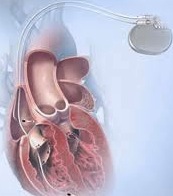Endocavitary pacemaker implanted in a 2 years old child due to epicardial system failure
Keywords:
Pediatría, Estimulación epicárdica, Estimulación endocárdicaAbstract
Historically, epicardial pacing has been the preferred pacing system in children, due to anatomical difficulties of venous access and the absence of endocardial electrodes with diameters suitable for small hearts. We present a case of a 2 years old with a history of coarctation of the aorta and outflow tract obstruction of the left ventricle by fibrous rim, as a complication of the surgical correction the patient presented a complete atrioventricular blockage, requiring implantation o f epicardial permanent pacemaker. During follow ups the patient presented syncopal episodes associated with cable stimulation failure due to an increased threshold, so he required a second operation to reposition the electrode.Due to repeated failure of stimulation for the same reason, we decided to implement an endocavitary systemDownloads

Published
How to Cite
Issue
Section
License
Aquellos autores/as que tengan publicaciones con esta revista, aceptan los términos siguientes:- Los autores/as conservarán sus derechos de autor y garantizarán a la revista el derecho de primera publicación de su obra, el cuál estará simultáneamente sujeto a la Attribution-NonCommercial 4.0 Internacional (CC BY-NC 4.0) que permite a terceros compartir la obra siempre que se indique su autor y su primera publicación esta revista. o admite fines comerciales. Permite copiar, distribuir e incluir el artículo en un trabajo colectivo (por ejemplo, una antología), siempre y cuando no exista una finalidad comercial, no se altere ni modifique el artículo y se cite apropiadamente el trabajo original. El Comité Editorial se reserva el derecho de introducir modificaciones de estilo y/o acotar los textos que lo precisen, comprometiéndose a respectar el contenido original.
- Los autores/as podrán adoptar otros acuerdos de licencia no exclusiva de distribución de la versión de la obra publicada (p. ej.: depositarla en un archivo telemático institucional o publicarla en un volumen monográfico) siempre que se indique la publicación inicial en esta revista.
- Se permite y recomienda a los autores/as difundir su obra a través de Internet (p. ej.: en archivos telemáticos institucionales o en su página web) antes y durante el proceso de envío, lo cual puede producir intercambios interesantes y aumentar las citas de la obra publicada. (Véase El efecto del acceso abierto).








